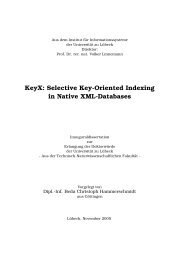Gesture-Based Interaction with Time-of-Flight Cameras
Gesture-Based Interaction with Time-of-Flight Cameras
Gesture-Based Interaction with Time-of-Flight Cameras
You also want an ePaper? Increase the reach of your titles
YUMPU automatically turns print PDFs into web optimized ePapers that Google loves.
CHAPTER 2. TIME-OF-FLIGHT CAMERAS<br />
.2-tap pixel:<br />
.4-tap pixel:<br />
.1 st<br />
.2 nd<br />
.s(t)<br />
.<br />
.A0 .A1 .A2 .A3 .A0 .A1 .A2 .A3<br />
.A0 .A2 .A0 .A2<br />
.A1 .A3 .A1 .A3<br />
Figure 2.5: Illustration <strong>of</strong> the measurement sequence for the samples A0, . . . A3 for both<br />
the 4-tap pixel and the 2-tap pixel.<br />
while increasing the signal-to-noise ratio <strong>of</strong> the measurement.<br />
While the 4-tap pixel resembles a straightforward implementation <strong>of</strong> the mea-<br />
surement principle introduced in Section 2.4 it has a major disadvantage. The four<br />
potential wells for storing the photoelectrons take up a large portion <strong>of</strong> the total space<br />
<strong>of</strong> one pixel. Thus, the actual photo-sensitive area <strong>of</strong> a pixel is very small, i.e. the 4-<br />
tap pixel has a low so-called fill factor. As a result either the size <strong>of</strong> a pixel has to be<br />
very large or the exposure time <strong>of</strong> the camera has to be increased. Both approaches<br />
have their drawbacks. Large pixels reduce the effective spatial resolution <strong>of</strong> the cam-<br />
era. At the same time, the extension <strong>of</strong> a pixel is limited because the photoelectrons<br />
travel to the potential wells by diffusion and the expected amount <strong>of</strong> time for this<br />
diffusion process increases quadratically <strong>with</strong> the mean distance the photoelectrons<br />
have to travel before reaching the potential wells. Longer exposure times reduce the<br />
temporal resolution and also introduce so-called motion artefacts, which we will dis-<br />
cuss in more detail at a later point.<br />
Instead <strong>of</strong> implementing the 4-tap pixel, most recent cameras rely on the so-<br />
called 2-tap pixel. Instead <strong>of</strong> having four potential wells for storing the photoelec-<br />
trons during the estimation <strong>of</strong> A0, . . . , A3, the samples are estimated in two consec-<br />
utive steps: First, the sensor integrates over two intervals <strong>of</strong> the periodic signal to<br />
estimate A0 and A2. For this operation only two potential wells are required; hence,<br />
20<br />
.t

















